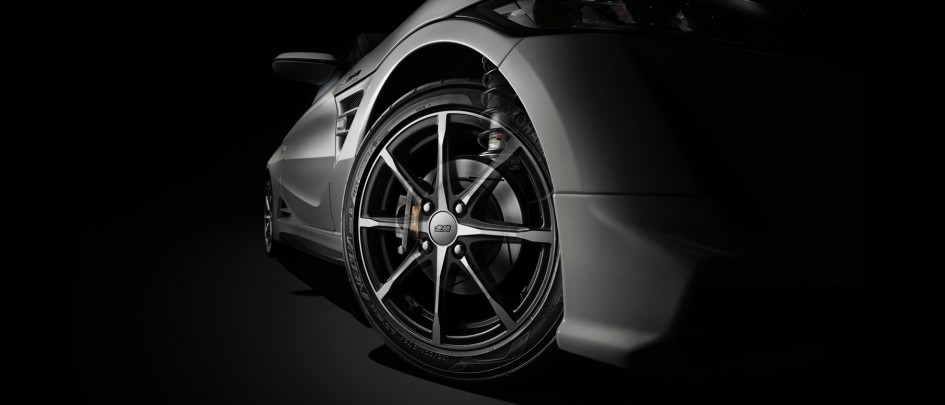Partager la publication "Honda S660 préparé par Mugen Motorsports 無限 Tokyo Auto Salon 2016 : S660 …Without Limit!"
Mugen Motorsports est une entreprise japonaise spécialisée dans le sport automobile fondée en 1973 par Hirotoshi Honda. En ce moment, il y a le Dakar en Argentine, le CES 2016 à Las Vegas, bientôt le NAIAS, c’est à dire le Salon de Detroit, …et on va donc parler maintenant du Tokyo Auto Salon qui ouvre mi-janvier ! 日本最大のカスタムカーの祭典、東京オートサロンの。 2016年は1月15日(金)、16日(土)、17日(日)の3日間開催。 In English: Japan’s largest custom car festival, the Tokyo Auto Salon. 2016 January 15 (Friday), 16th (Saturday), 3 days held on the 17th (Sunday). Mais alors pourquoi donc on en parle déjà ? Eh bien parce que Mugen Motorsports présente la Mugen S660 sur base de Honda S660. Et attention, ce Tokyo Auto Salon, c’est hosted by the Nippon Auto Parts Aftermarket Committee (NAPAC). Donc, c’est un peu un genre de SEMA Show local. C’est donc différent du Tokyo Motor Show 2015 avec les annonces constructeurs ! Et donc, on va surfer sur cette annonce pour dédier un article sur la S660 …de série.
Honda S660
Honda S660, c’est une automobile particulière, a two-seat sports car which fits in the very small Kei car category. Et je ne sais pas toi ?, mais moi, depuis toujours, je regarde DirectAuto à la TV sur D8 actuellement, et en 2015, Grégory Galiffi, le présentateur était au Japon pour un reportage passion. Vous savez, ces type de sujets intitulés « Aller-Simple », qui présente une région de France, et ses passionnés, ou un pays à l’autre bout du monde ! Ce qui en fait une superbe émission auto, si ce n’est la meilleur à l’heure actuelle, en course avec dans un autre genre Top Gear France, qui a repris sa diffusion ! L’autre jour, le Japon était à l’honneur, le reporter était au volant de la S660 ! C’est un véhicule typique de là-bas, faisant partie de la catégorie des Kei-Car. Je découvre alors cette Honda et j’adore ! Justement je voulais publier un post dédié Design & Moteur à cette Honda S660 ! Aussi, cette auto me fait penser à la Renault Wind… qui hélas n’est pas vraiment connu en France, mais que j’apprécie beaucoup autant en photo qu’en vrai.
Kei-Car ?
Kei car, K-car, or kei jidōsha (軽自動車?, lit. « light automobile »), is a Japanese category of small vehicles, including passenger cars (kei cars or kei-class cars), microvans, and pickup trucks (kei trucks or kei-class trucks).
Histoire de constructeur – Honda & Mugen
Soichiro Honda (本田 宗一郎, Honda Sōichirō?), né en 1906, est un ingénieur et industriel japonais, fondateur de la Honda Motor Company en 1948. Il est l’exemple du simple mécanicien aussi inventif qu’ambitieux à l’origine d’un constructeur automobile multinational. Honda devint numéro un mondial de la moto en moins de dix ans, puis un géant de l’automobile.
Honda père & Mugen fils
Contrairement à une idée souvent répandue, Mugen n’est pas une filiale de Honda. Il s’agit d’une entreprise financièrement indépendante, même si, de par les liens familiaux, les connexions sont multiples entre les deux sociétés. En effet, Hirotoshi Honda, fondateur de Mugen est le fils de Soichiro Honda, fondateur de la marque Honda.
Honda & Mugen Motorsports
Mugen Motorsports ( M-TEC Cie., Ltd ) a été fondee en 1973, par Hirotoshi Honda et Masao Kimura.
Mugen, meaning ‘Without Limit’, or ‘Unlimited’, (hence the commonly placed word ‘Power’ after, denoting ‘Unlimited Power’) is an engine tuner and parts manufacturer closely associated with the Honda Motor Company.
L’entreprise Mugen 無限, qui signifie infini en français, s’est longtemps spécialisé dans la préparation des voitures Honda, qu’il s’agisse de modèles destinés à la commercialisation ou à l’engagement en compétition. Cette activité a trouvé son prolongement dans le développement de programmes sportifs autonomes. Mugen a ainsi notamment conçu des moteurs de F3000 et de Formule 3.
Mugen s’est également impliqué en Formule 1 dès 1991. Alors que Honda se lançait dans la conception d’un moteur V12, Mugen préparait pour le compte de l’écurie Tyrrell les V10 Honda utilisés précédemment par McLaren, le moteur conservant l’appellation Honda. À partir de 1992, le moteur a été renommé Mugen-Honda pour équiper l’écurie Footwork. Si l’engagement originel de Mugen en Formule 1 consistait en une simple préparation de moteurs Honda, il a évolué peu à peu fin 1992 quand Honda s’est retiré officiellement de la F1.
Mugen a alors conçu en interne de nouveaux moteurs, avec, il est vrai, l’assistance technique bienveillante de Honda. Après Arrows, Mugen a ainsi équipé avec succès les écuries Ligier (victoire d’Olivier Panis au Grand Prix de Monaco 1996), puis Prost Grand Prix et enfin Jordan (victoire de Damon Hill en 1998 et deux succès de Heinz-Harald Frentzen en 1999).
Mais le retour officiel de Honda en Formule 1 en 2000 a rendu inconfortable la position de Mugen. Après une année de cohabitation (Mugen équipait Jordan tandis que Honda motorisait BAR), Mugen s’est retiré pour laisser le champ libre à Honda, qui reprit le rôle de motoriste de Jordan.
Mugen continue d’être très actif dans le sport automobile japonais et mondial, en préparant notamment les moteurs de différentes Honda Civic et Accord engagées en rallye et circuit.
埼玉県朝霞市。ホンダの市販車用の各種パーツ、レーシングパーツとカートの製造、販売。
Mugen Motorsports (無限) est un préparateur sportif qui notamment fournit des pièces hautes performances pour les amateurs de compétitions automobiles. Mugen a également préparé des moteurs de Formule 1 est actuellement a recentré ses activités vers le tuning et team Motorsports avec des voitures Honda dans la série JGTC (Japan Grand Touring Championship) que l’on connait par son nom : Super GT スーパーGT (Sūpā GT)
Honda & McLaren
En 2015, Honda revient dans la course du championnat de F1 avec le développement de moteur Power Unit V6 comme motoriste pour le team McLaren et la monoplace F1 McLaren.
A lire, en complément : Le team McLaren présente la MP4-30 moteur Honda, au MTC, le 29/01/2015 #MakeHistory
Contexte posé, regardons cette superbe Honda S660 préparé par Mugen Motorsports, mais d’abord, présentons la Honda S660 de base !
Le design de la S660 Honda
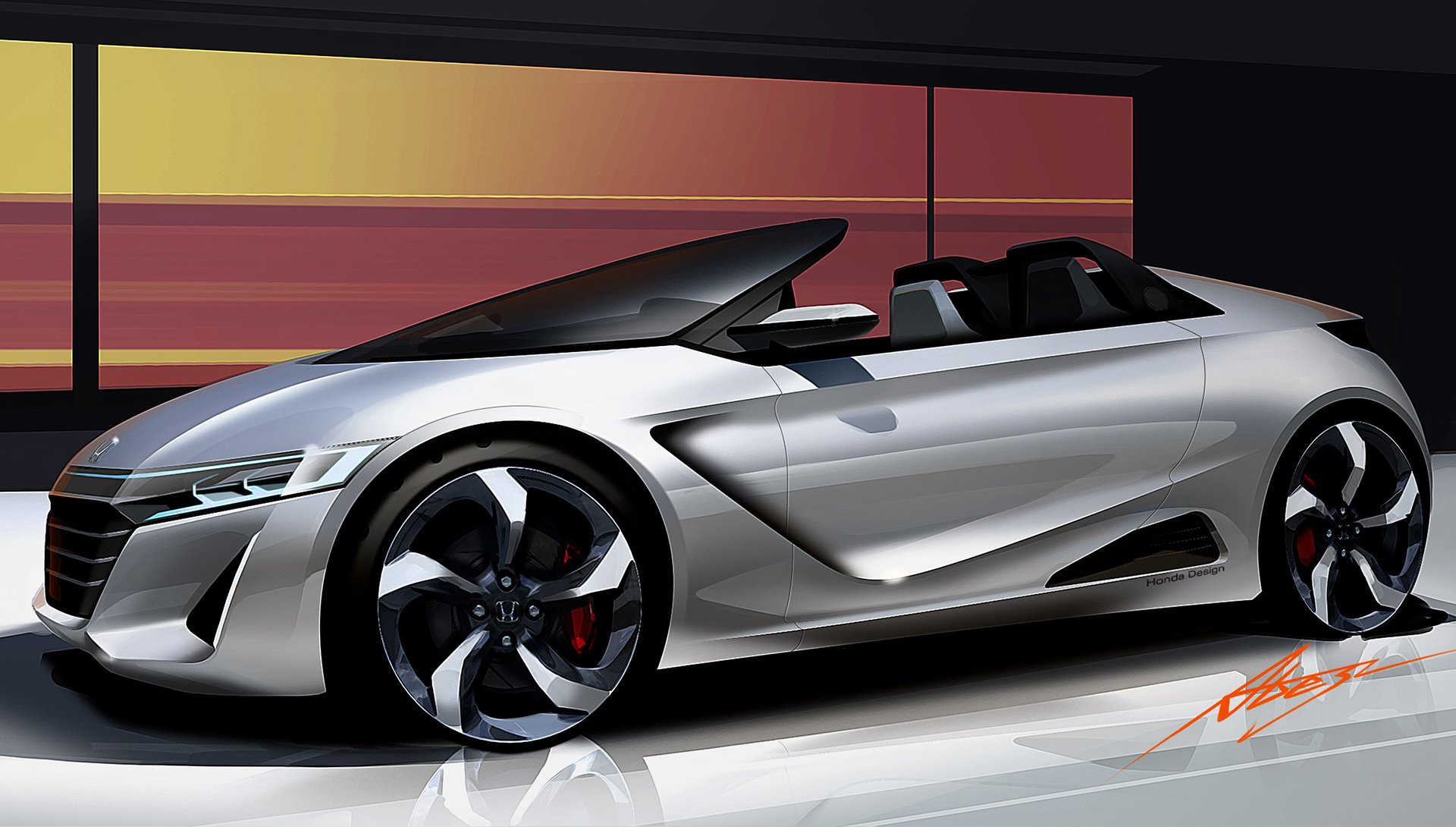
Honda S660 – sketch design – front / avant
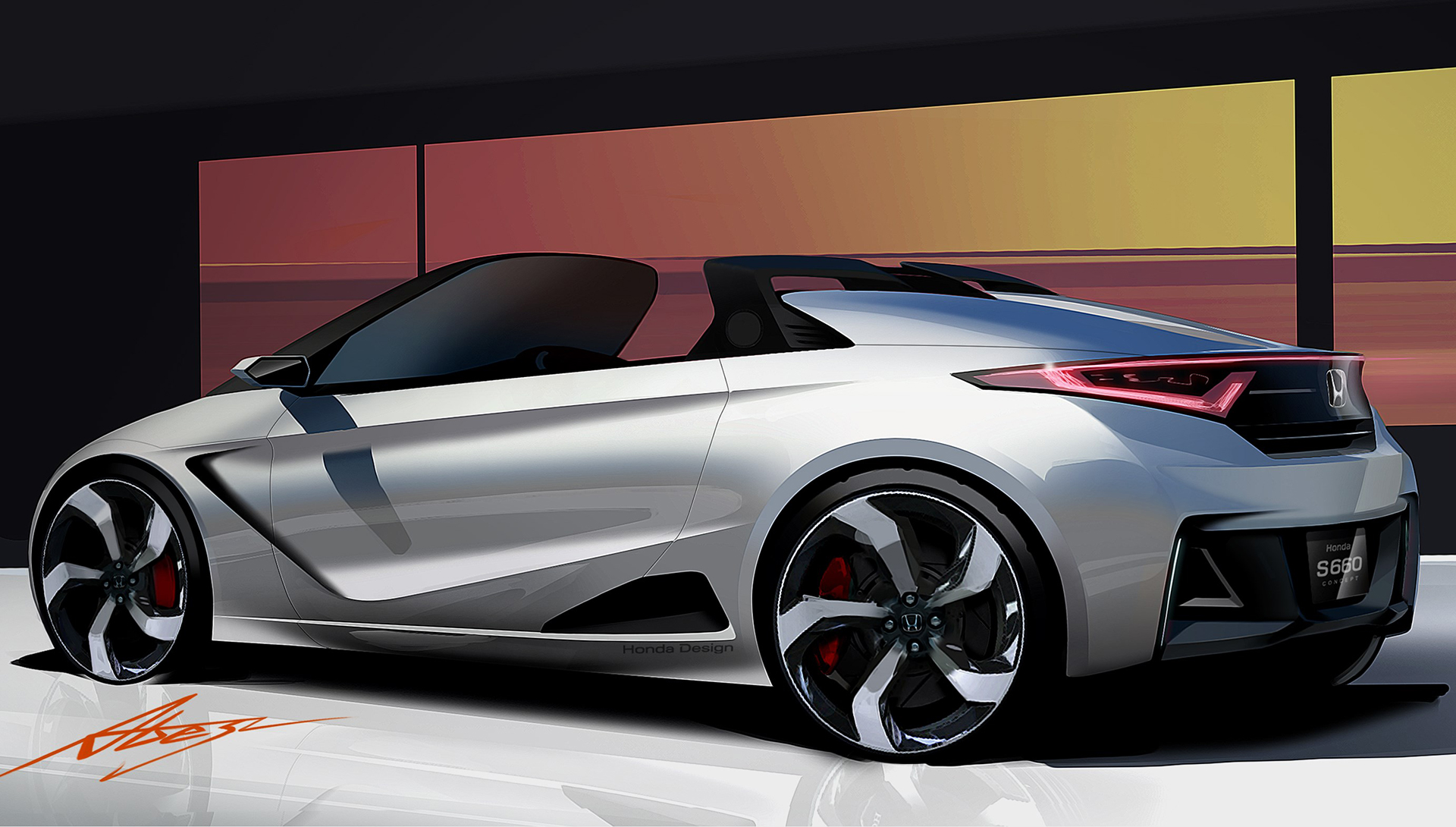
Honda S660 – sketch design – rear / arrière
Dans la pure tradition des cabriolets Honda, ce nouveau modèle accole la lettre S à sa cylindrée, et succède à la S500 de 1963. L’auto a tous les attributs d’un vrai roadster moderne et sportif : large entrée d’air, ouïes latérales, sortie d’échappement centrale.
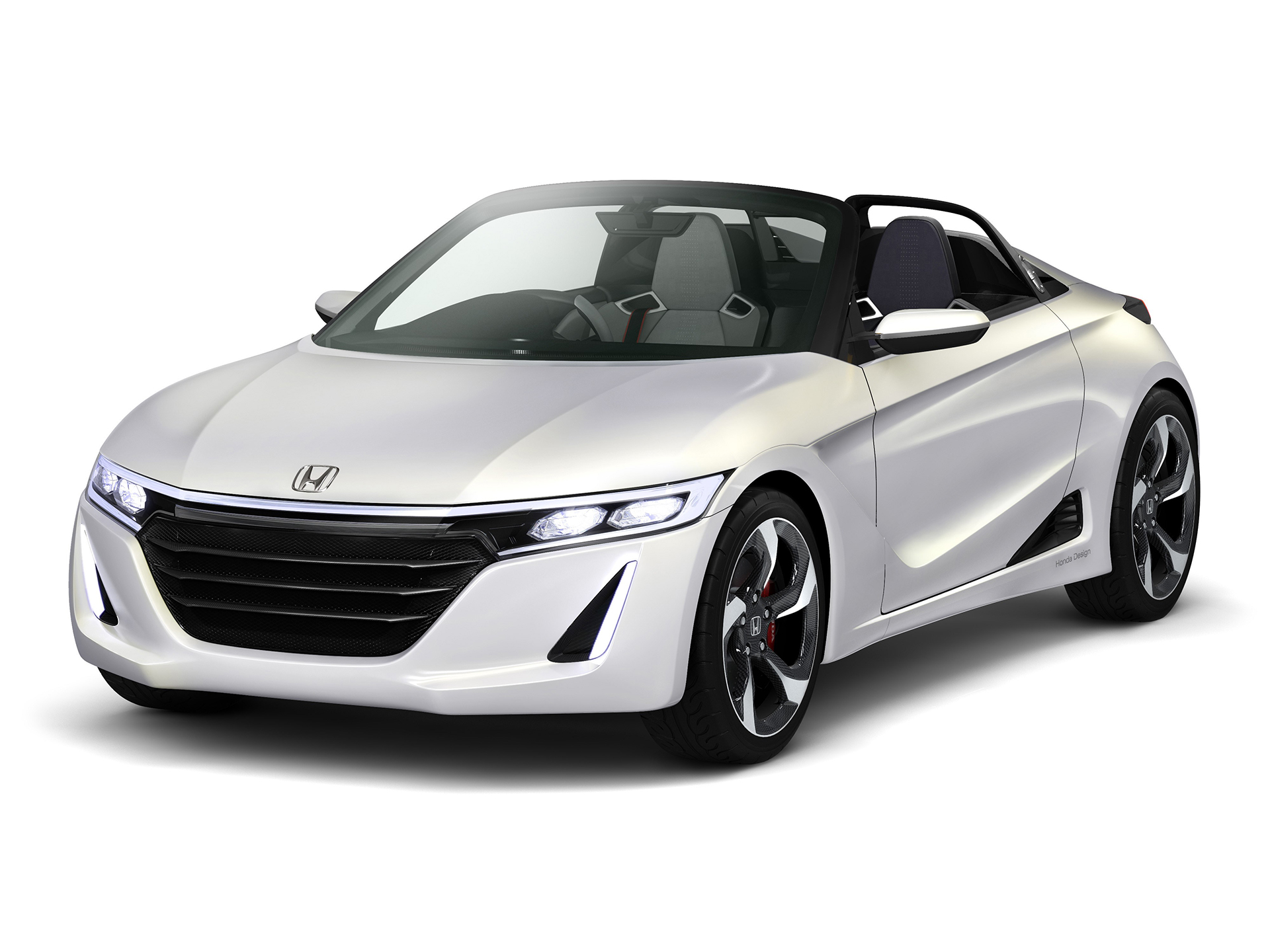
Honda S660 – Tokyo Motor Show – 2013 – front / avant
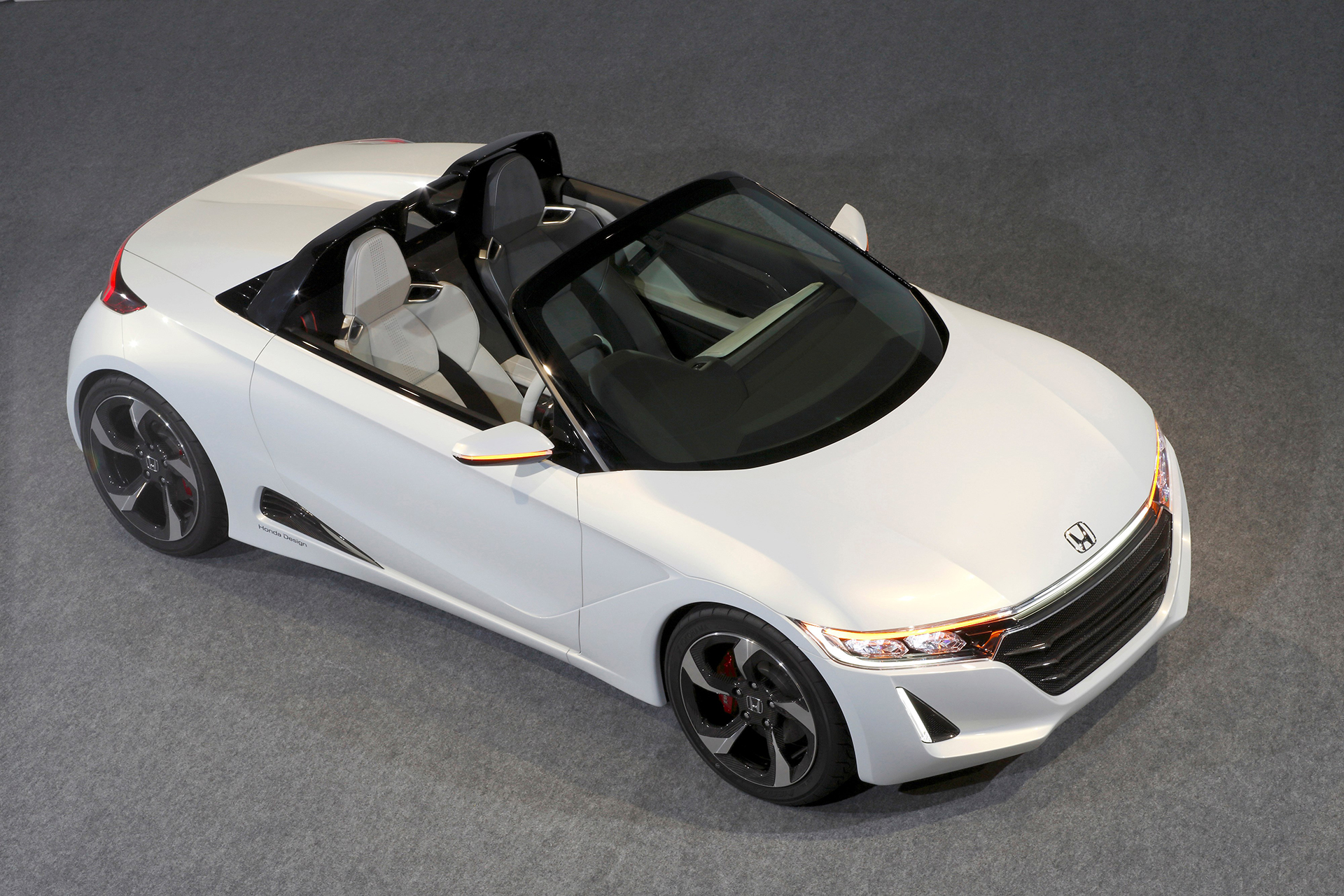
Honda S660 – Tokyo Motor Show – 2013 – top (open) / toit (ouvert)
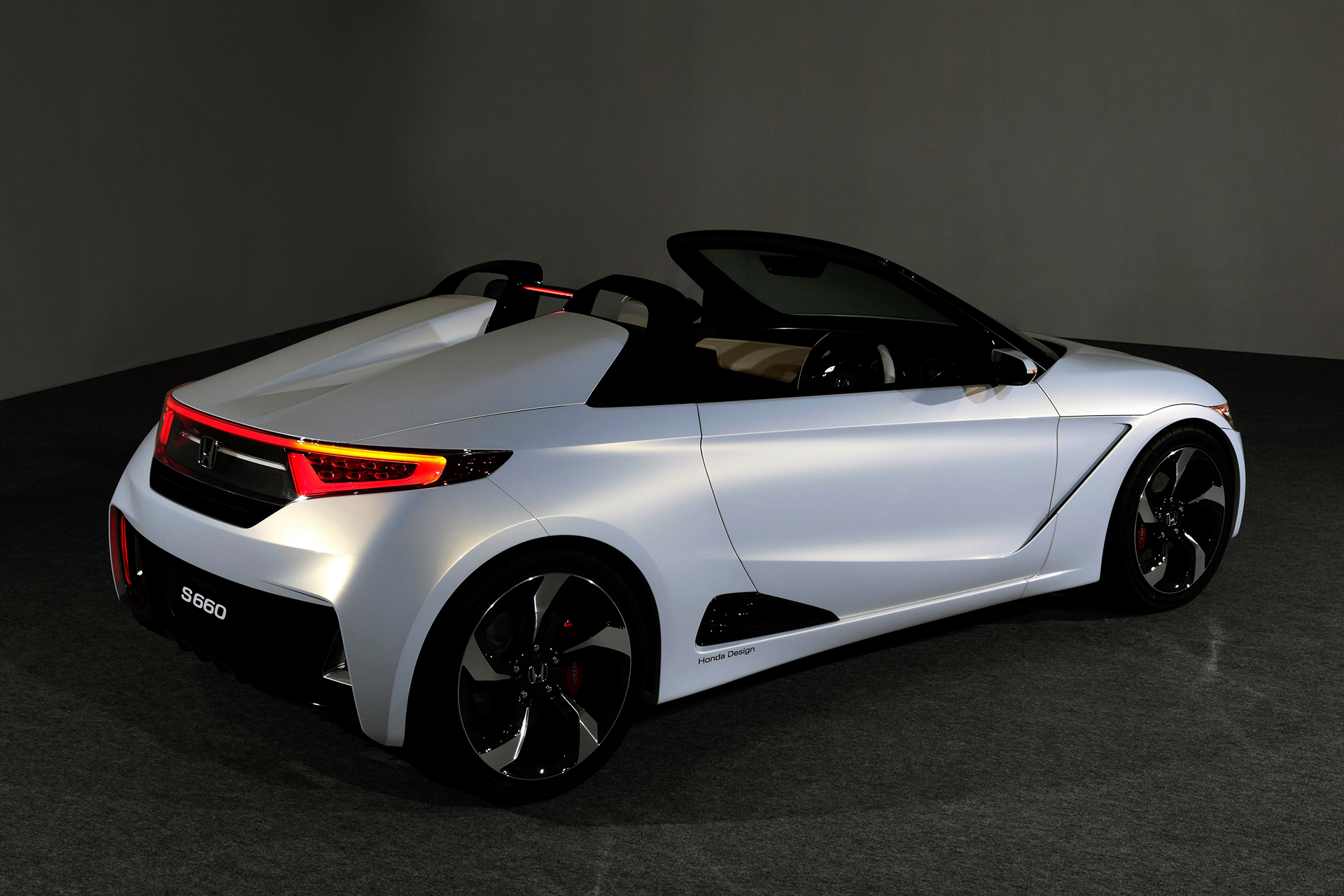
Honda S660 – Tokyo Motor Show – 2013 – rear / arrière
Le design intérieur de la S660 Honda
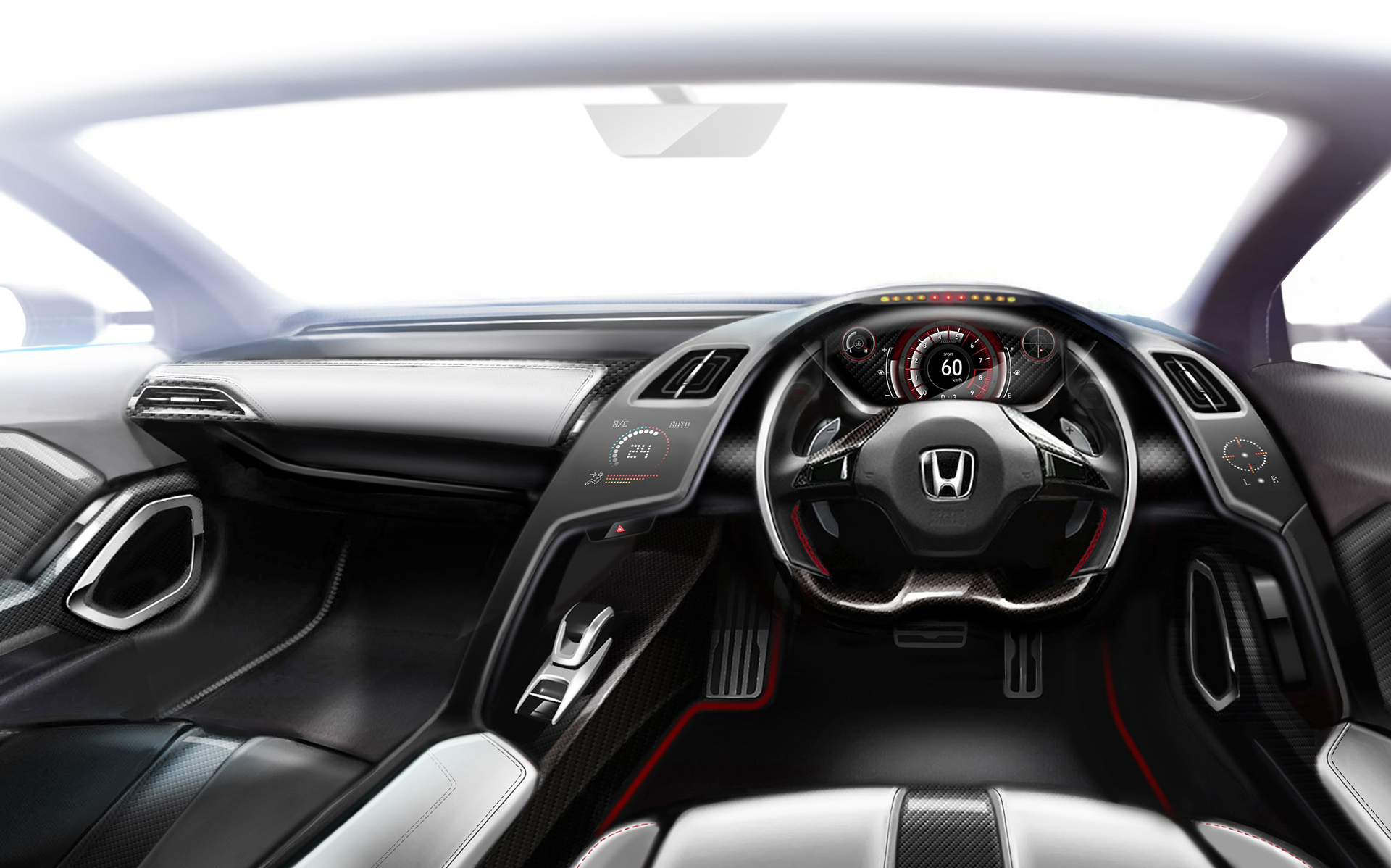
Honda S660 – sketch design – interior / intérieur
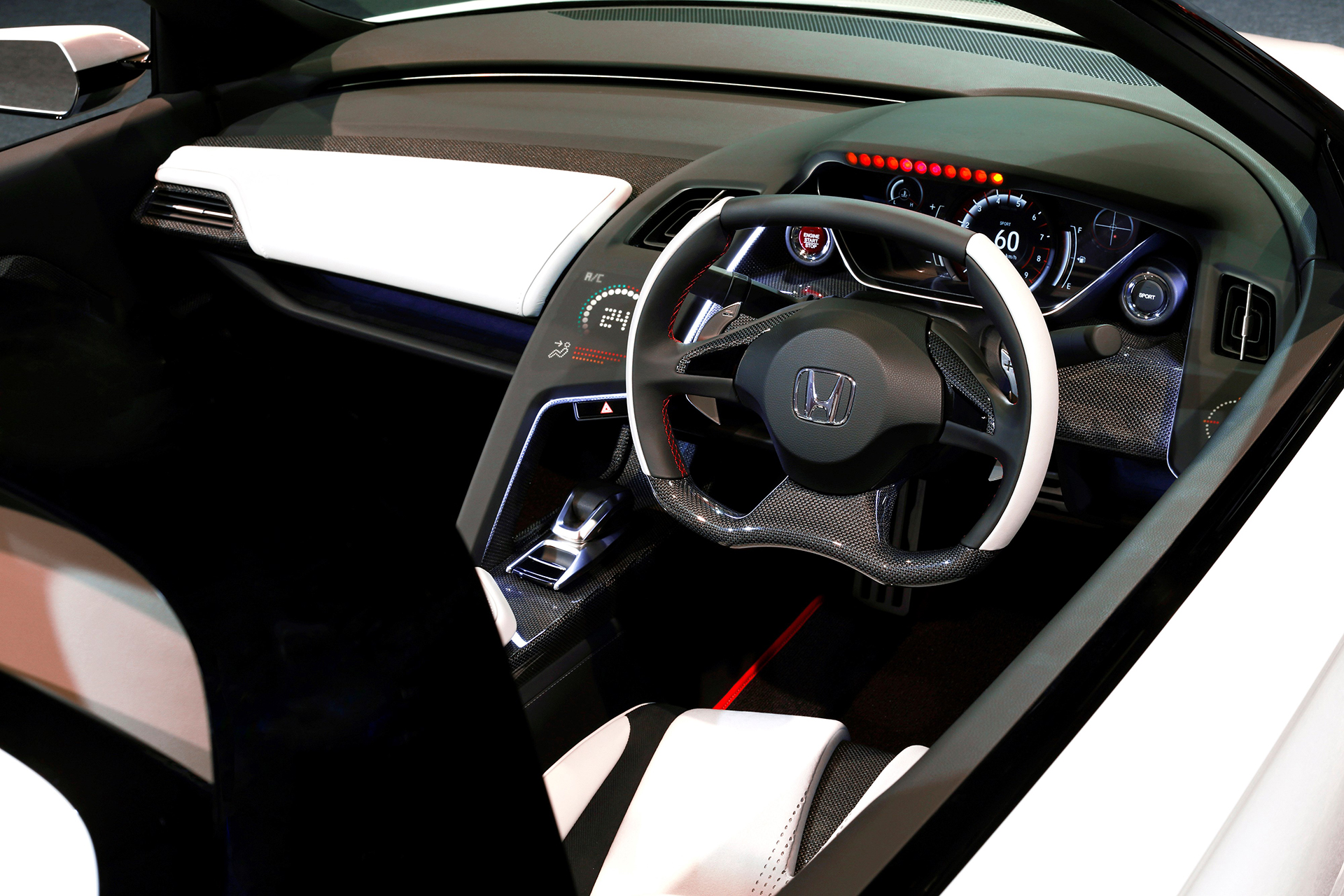
Honda S660 – Tokyo Motor Show – 2013 – interior / intérieur
A l’intérieur, Honda a soigné tous les détails. On se croirait presque à bord d’une mini Honda NSX : sièges sport, pédalier alu, volant à méplat, compteurs central avec zone rouge débutant à plus de 7000 tr/min.
A voir : NSX. La supercar aux 4 moteurs Honda. Présentation de l’Acura NSX next-gen au NAIAS 2015
Le moteur de la S660 Honda
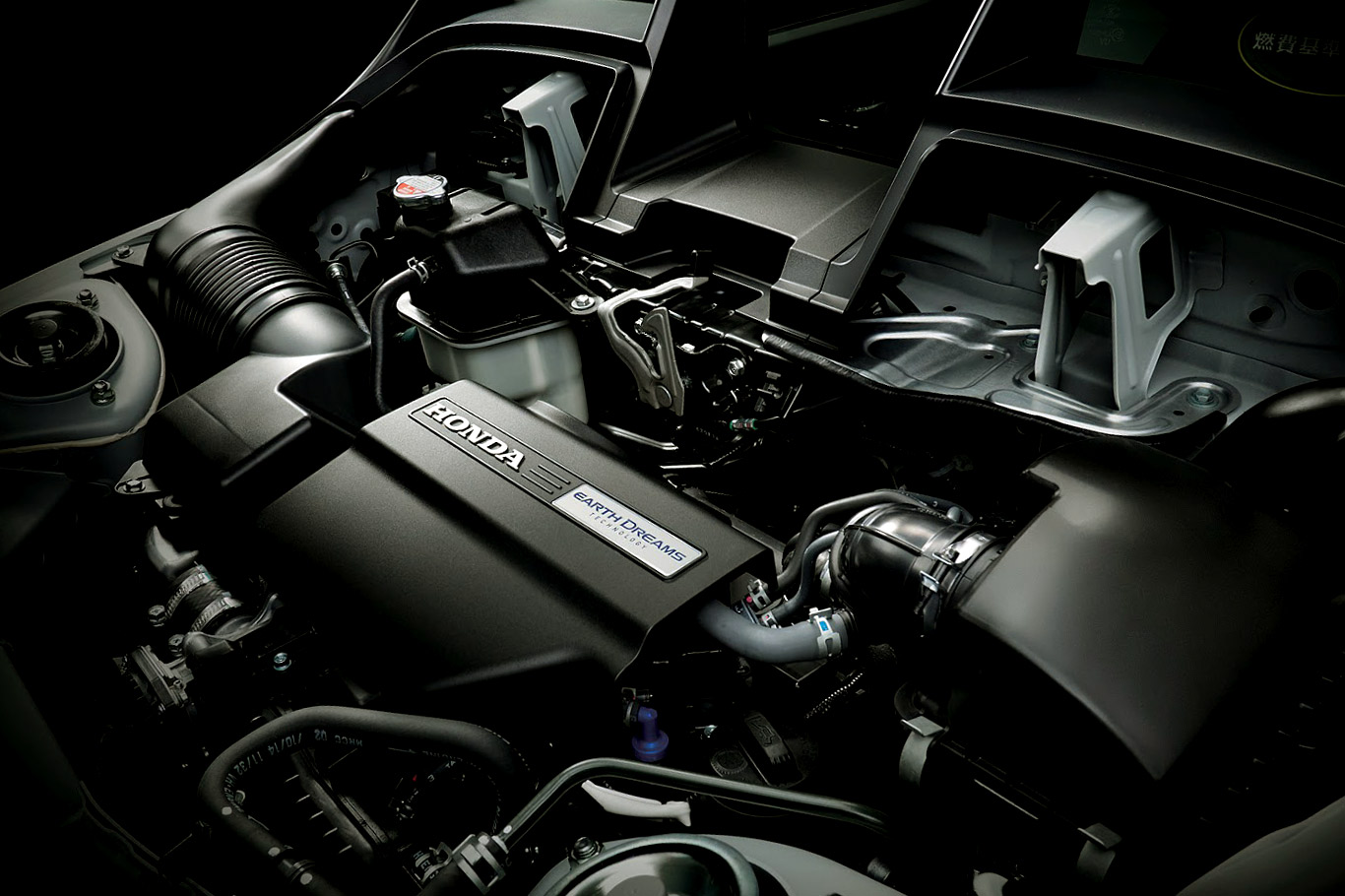
Honda S660 – rear engine under the hood / sous le capot moteur arrière
La Honda S660 est un petit roadster animé par un 3-cylindres turbo implanté en position centrale arrière. Le moteur est un petit 3-cylindres de 660 cm3 (d’où son nom) délivrant juste 64 ch !
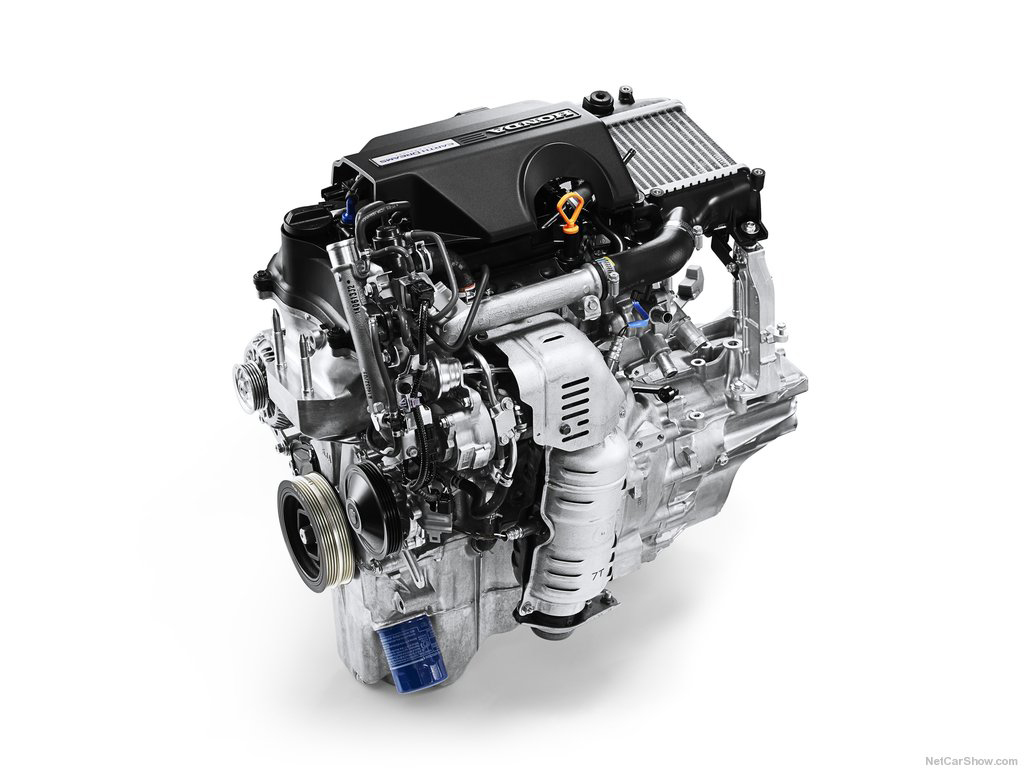
Honda S660 – engine / moteur
Une puissance restreinte aux contraintes techniques imposées pour faire partie de la catégorie des ‘Kei Cars’. Le plaisir de conduite reste présent grâce à un poids limité avec ses 800 kg environ, une bonne répartition des masses (45/55) et une transmission aux roues arrière.
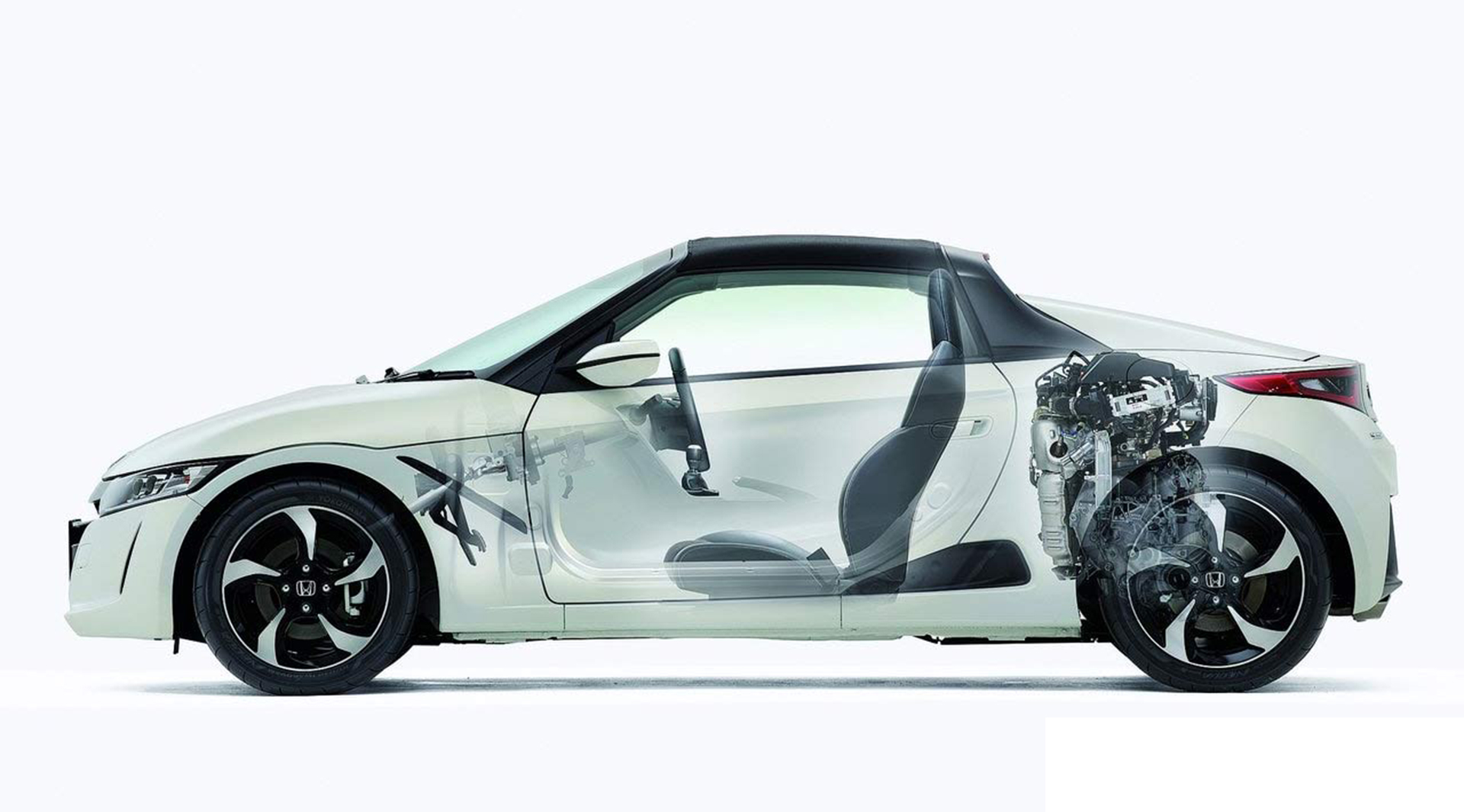
Honda S660 – powertrain
Honda S660 by Mugen
Based on the “Super Little Sports” concept, this model contains performance parts that maximize driving excitement, as well as high-functionality parts which include not only front, rear, and side spoilers, but also other aero parts including replaceable front and rear aero fenders, wings, hard top, aero bonnet, and aero engine hood.
Design de Honda S660 Mugen
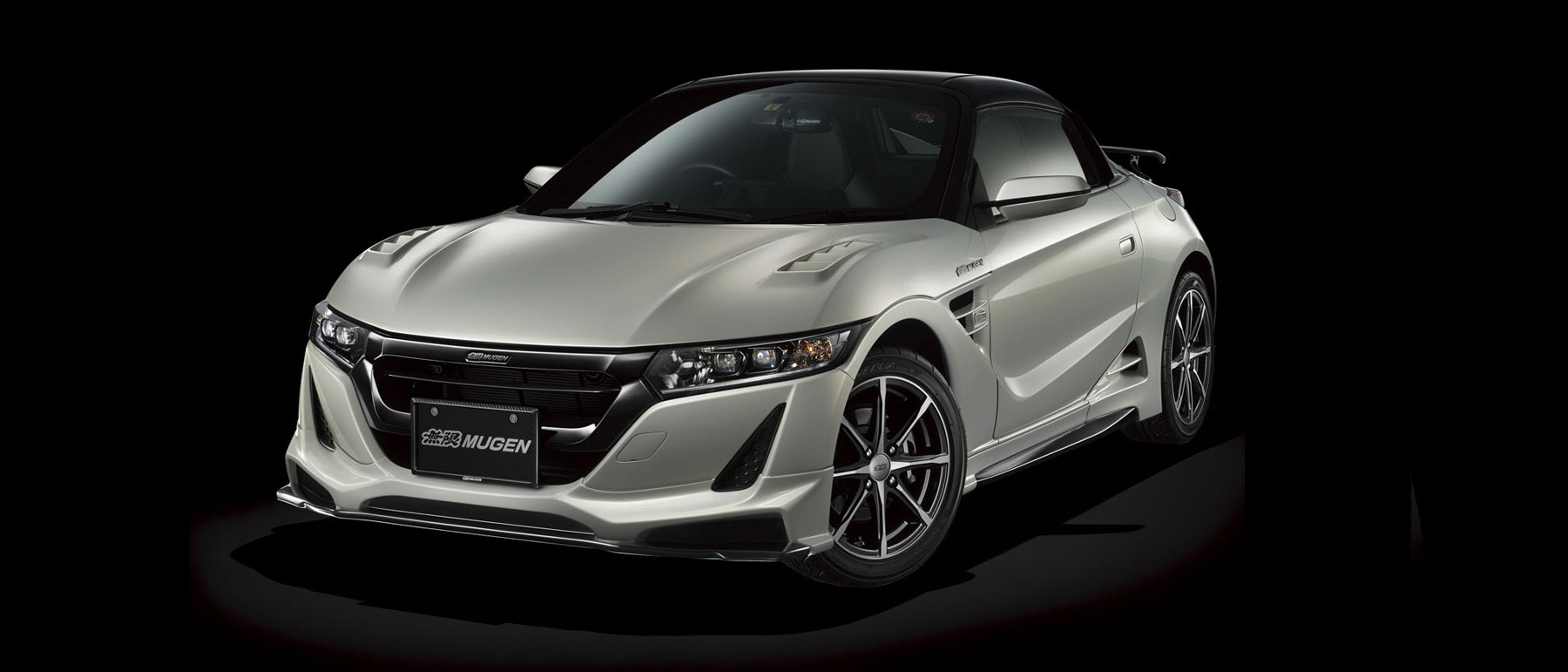
Honda S660 Mugen -2016 – front / avant
Honda S660 Mugen est radicale : toit fixe, large bouclier avant, extracteurs d’air sur le capot avant et les ailes avant, extracteur et aileron fixe.
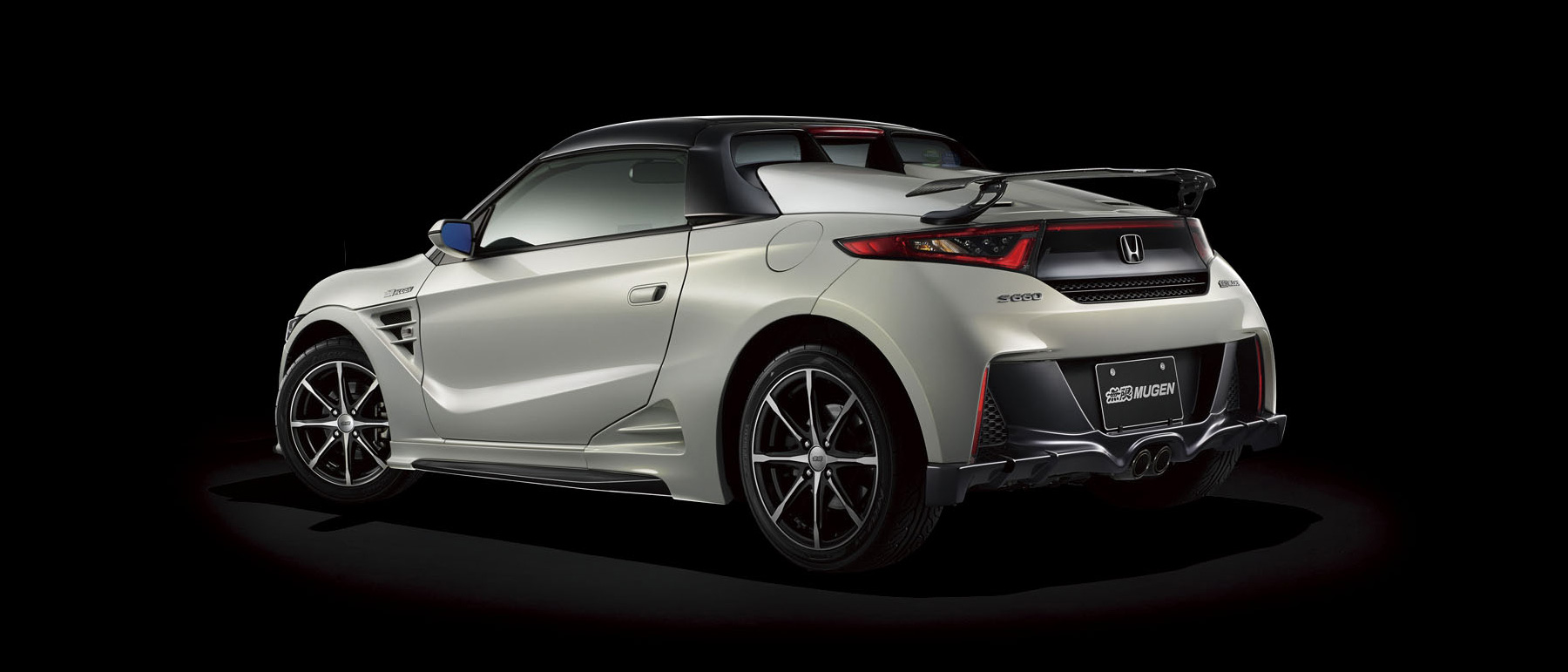
Honda S660 Mugen -2016 – rear / arrière
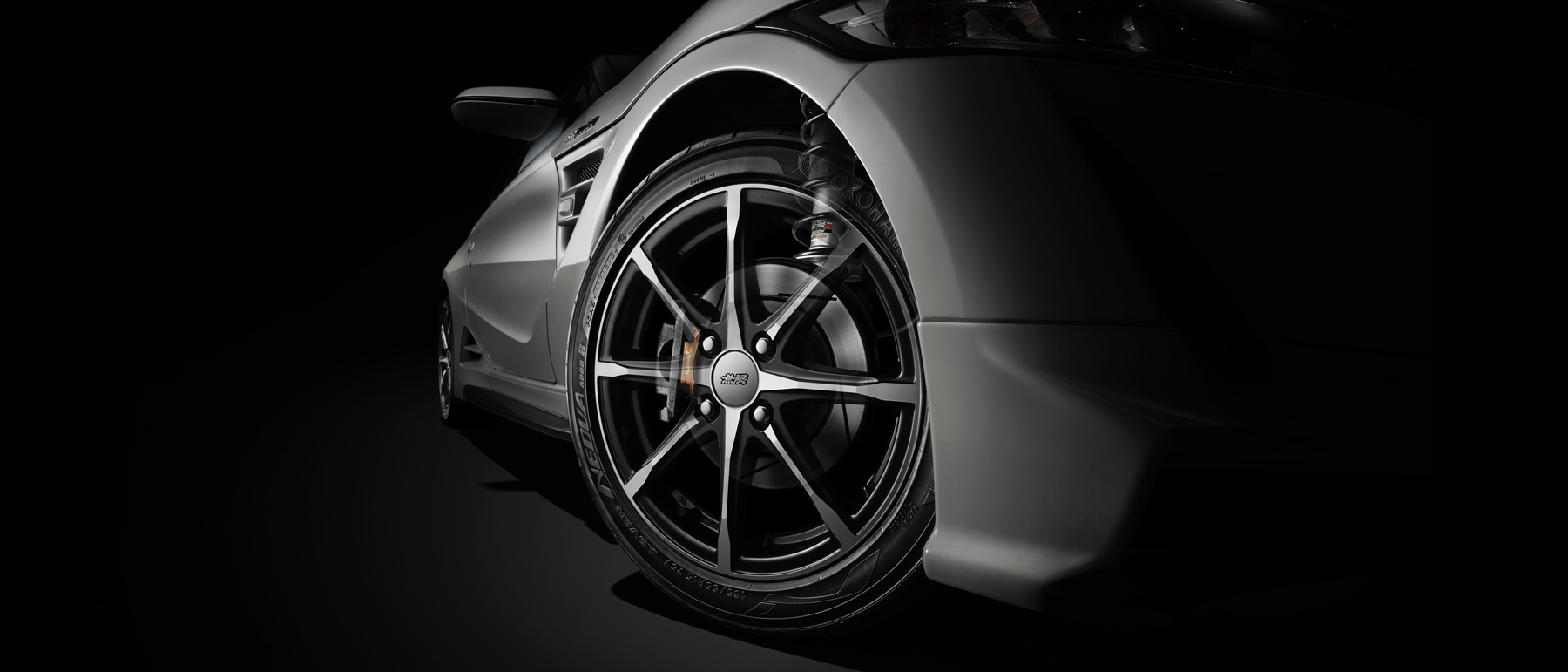
Honda S660 Mugen -2016 – wheel / jante
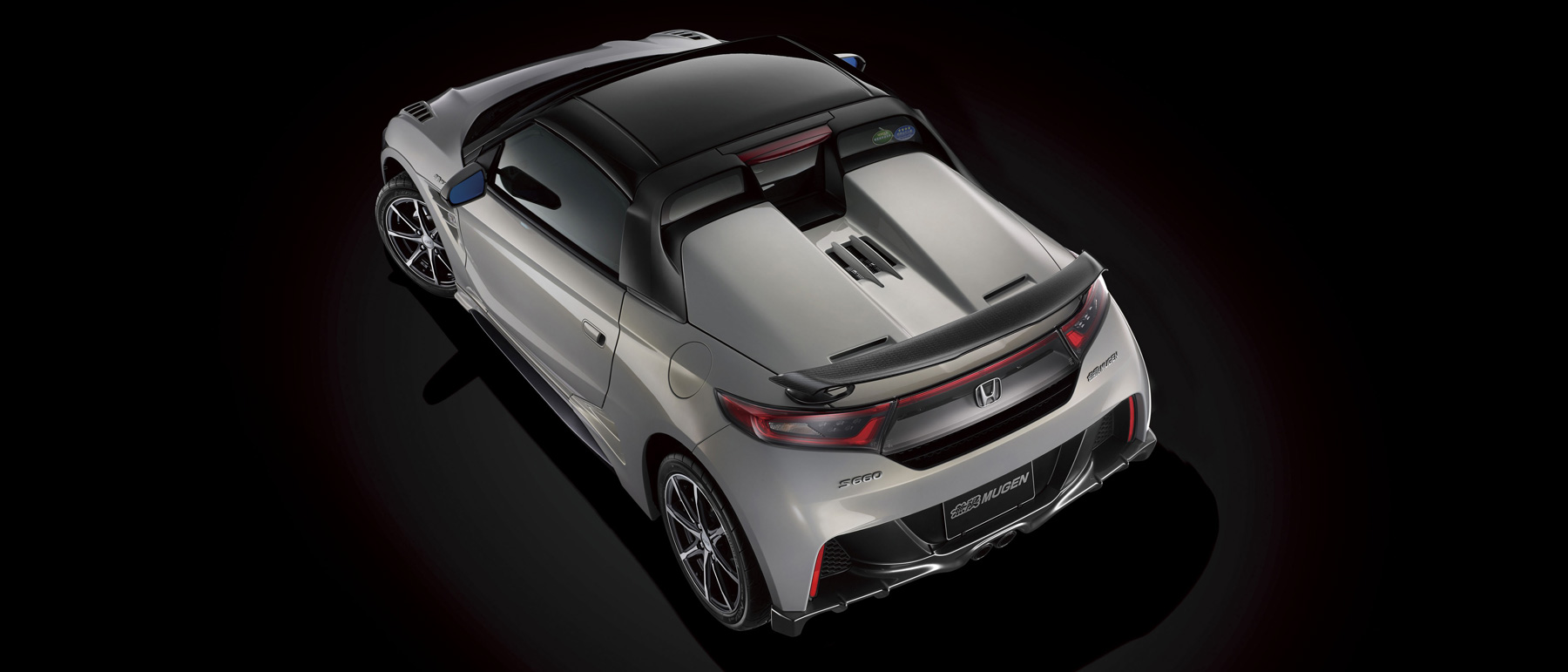
Honda S660 Mugen -2016 – rear top / toit arrière
Design intérieur de Honda S660 Mugen
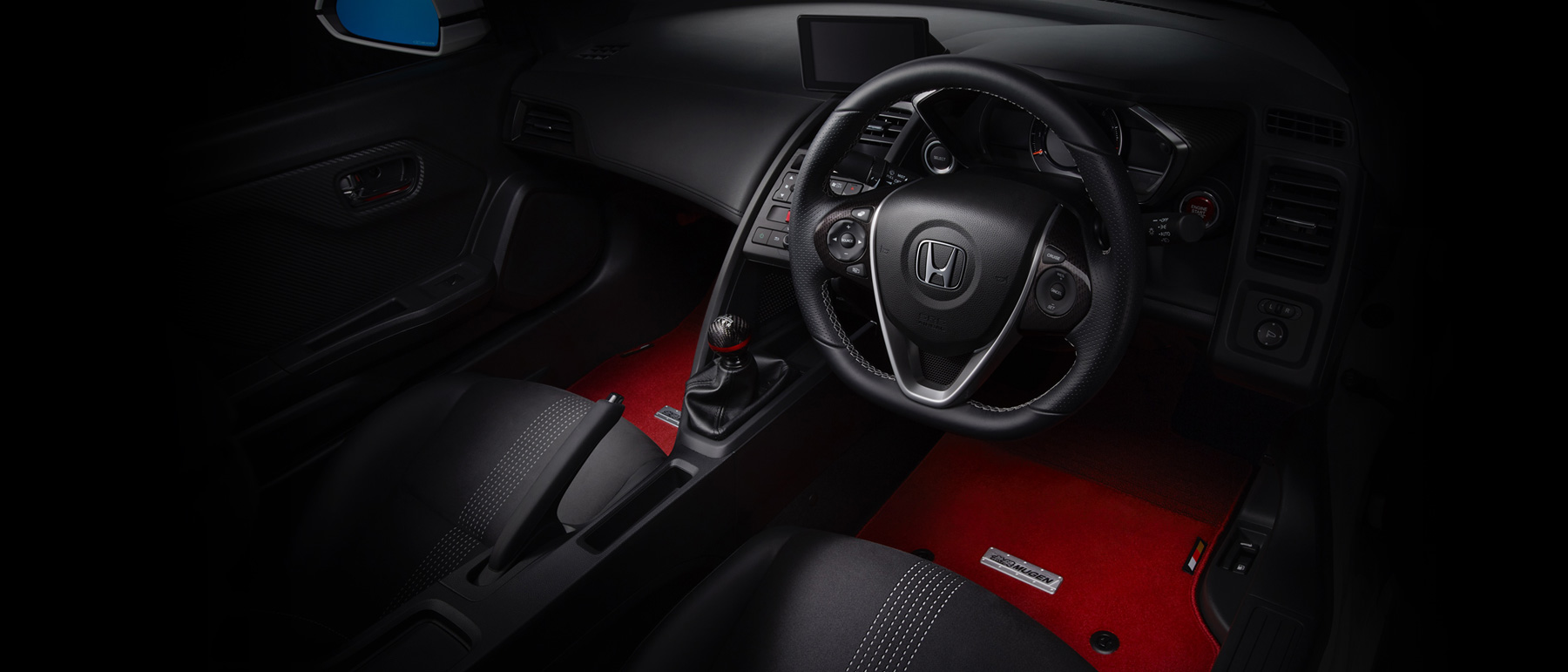
Honda S660 Mugen -2016 – interior / intérieur
Moteur de Honda S660 Mugen
Pas d’infos sur la motorisation embarqué… on en saura davantage lors de l’ouverture du prochain Tokyo Auto Salon, mi-janvier 2016.
Mugen n’est pas du genre à se contenter de juste 64 ch.
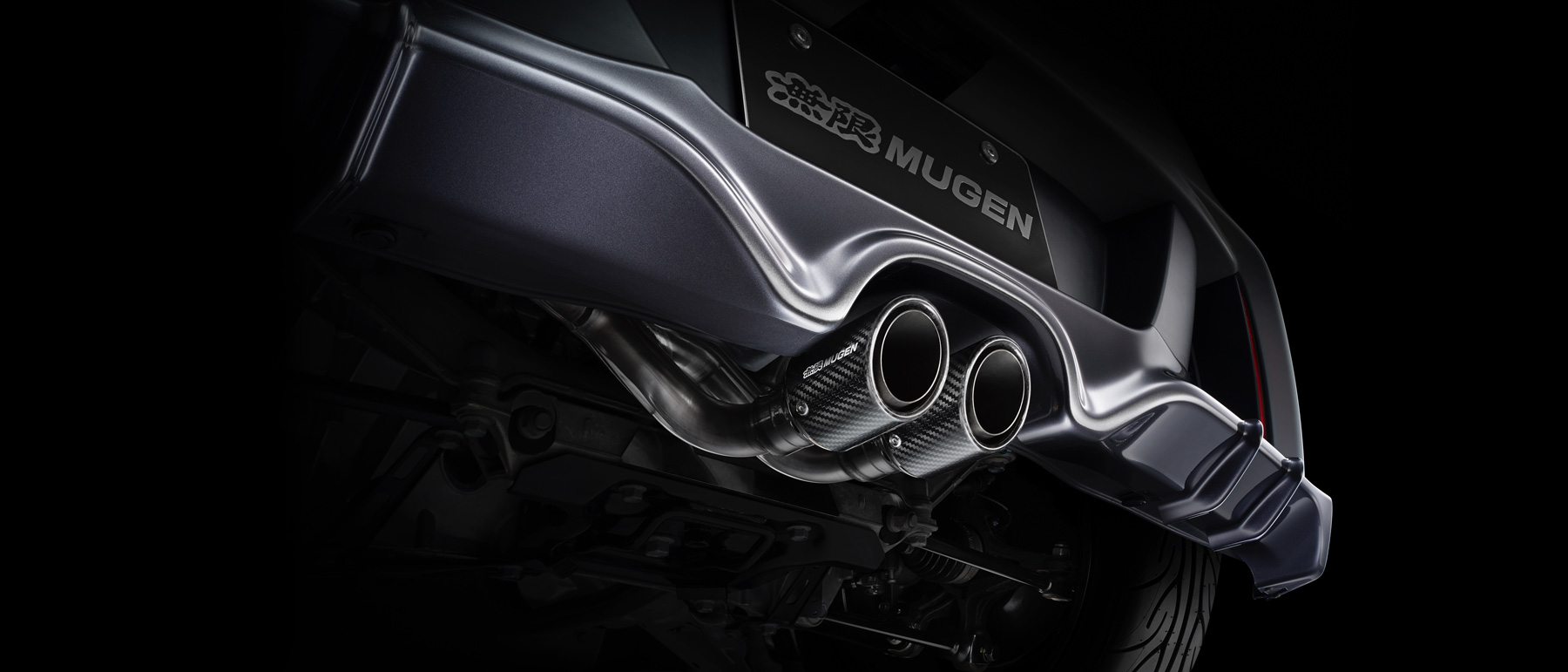
Honda S660 Mugen -2016 – exhaust / sorties de d’échappement
English summary
MUGEN POWER 2016 – TOKYO AUTO SALON 2016 EXHIBIT OVERVIEW
MUGEN (M-TEC Co., Ltd., President: Tomoyuki Hashimoto) (hereafter,“MUGEN”) will be exhibiting four-wheeled vehicles that present a variety of customization ideas, together with motor sports racing vehicles, at the Tokyo Auto Salon 2016 (promoter: Tokyo Auto Salon Association (TASA)) to be held at Makuhari Messe from January 15 (Friday) – 17 (Sunday), 2016.
The 2016 MUGEN concept is “MUGEN POWER 2016”. The event will see the first-ever exhibits of the “Honda S660 MUGEN RA Prototype » – a Honda S660 with complete MUGEN specifications – as a reference exhibit, as well as the “MUGEN CIVIC TYPE R Concept” – a CIVIC TYPE R with special Auto Salon specifications. In the Honda vehicle category, we will also be exhibiting the MUGEN specification S660, STEP WGN SPADA, and VEZEL that were announced in 2015. In the motor sports category, we will be exhibiting the Team MUGEN SF14 which raced in the 2015 Super Formula Series – Japan’s top formula series, and the SHINDEN YON electric motorcycle which raced for Team MUGEN in The Isle of Man Tourist Trophy Race – a historical and traditional street race.
Honda S660
新型オープンスポーツ「S660」発表会ライブ中継(アーカイブ) full video
2015/3/30、新型オープンスポーツ「S660(エスロクロクマル)」発表会の模様をライブ中継しました。メディア向け発表会の模様、また開発者インタビューや純正アクセサリー紹介などご覧ください♪
00:00 オープニング / Opening
02:05 発表会 / recital
13:15 ボディカラー、インテリア、CONCEPT 紹介 / body color, interior, CONCEPT
17:36 開発者インタビュー / Developer Interview
28:32 生産現場映像「FACTORY S660」 / production site video
31:20 試乗インプレッション / test drive impressions
33:31 ロールトップ脱着&収納実演 / demonstration
46:50 S660の主な特徴ご紹介 / feature Introduction of S660
53:20 オフィシャルサイト、スペシャルサイトご紹介 / Official Site Introduction
55:37 純正アクセサリー紹介 / accessories Introduction
Honda S660 design
The Honda S660 is a two-seat sports car which fits in the very small Kei car category. It is manufactured by the Japanese manufacturer Honda. The car weighs approx 830kg with manual transmission and 850kg with CVT auto. A prototype was shown at the November 2013 Tokyo Motor Show, the major Japanese auto show event. It is the successor to the Honda Beat. The naming convention of using the letter ‘S’ followed by the engine displacement is a long held Honda tradition going back to Honda’s first production car, the Honda S500
The first driving review was a June 2015 review of a Japanese market prototype driven by Top Gear in Tokyo. The author felt the car was « supremely manoeuvrable » but lacked power, something he hoped an export model with a larger motor would cure. He felt that such an export model might be a potential Mazda MX-5 Miata competitor.
The S660 is a very lightweight, mid-engined, roadster sports car. Its dimensions, because of kei car Japanese legislation, is almost identical to the 1990s Honda Beat, and uses the same three cylinder engine with mechanical improvements.
The development team of the S660 was led by Ryo Mukumoto who beat out 400 other participants in Honda’s in-house competition. Honda made him the youngest lead engineer in the company’s history even though he had no engineering experience. He was 22 when he was chosen and was given 5 years to develop the sports car.
Its introduction signals a return to two-door sports coupes from Honda, taking the smallest position below the larger Honda CR-Z and the top level luxury Honda NSX. It is a modern version of Honda’s first mass-produced car, the Honda S500 introduced in 1963.
The mid-engine design balances weight on the front and rear of the car to provide good handling qualities. The design is claimed to have 45/55 front/rear weight balance (exactly even between the axles).
Honda S660 engine
Only one engine is available – the S07A, although it has been modified to fit the S660’s more sporting image. The Japanese Kei car model would be powered by a 660 cc motor with approximately 63 hp and 104 N·m torque to meet Kei regulations. An export or US market version was hinted to use motors such as a turbocharged 1.0 liter motor with around 127 hp.
The roadster measures 3,395 mm (133.7 in) in length, 1,475 mm (58.1 in) in total width and 1,180 mm (46.5 in) in height in order to be within limitations for Japan’s Kei car. It comes with a choice of a 6-speed manual transmission or a CVT with paddle shifters, both options being offered on the two trims available (alpha and beta).
FACTORY S660 ー 巧みの技でつくる。生産の現場のこだわり
走りへの熱い想いを込めたスポーツカーS660。ミッドシップ・レイアウト、オープン・2シーターという「走る喜び」を徹底追求した専用パッケージをより精度高く、かつ効率良く造り上げるために、Hondaは生産ラインにもこだわり、「人の技」を積極的に組み込んだ専用の製造工程を構築し、これに挑んだ。
Sports car S660 put the passion to run. Midship layout, open 2 more accurately a dedicated package that thorough pursuit of « running joy » that-seater, and in order to efficiently build up, Honda is well stick to the production line, incorporating the « tricks of the people » actively to build a dedicated manufacturing process, and challenged in this.
Mugen S660
Based on the “Super Little Sports” concept, this model contains performance parts that maximize driving excitement, as well as high-functionality parts which include not only front, rear, and side spoilers, but also other aero parts including replaceable front and rear aero fenders, wings, hard top, aero bonnet, and aero engine hood.
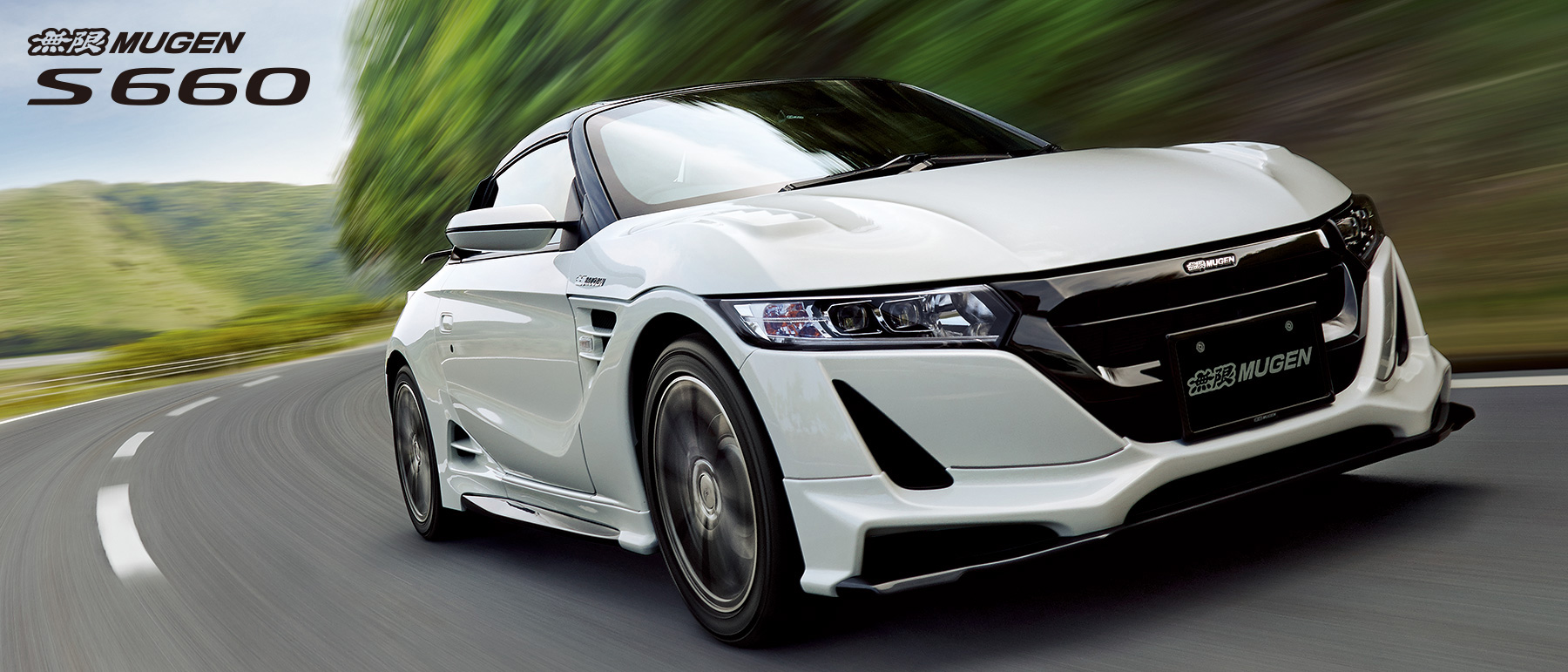
Honda S660 Mugen – 2016 – front / avant – on road / sur route
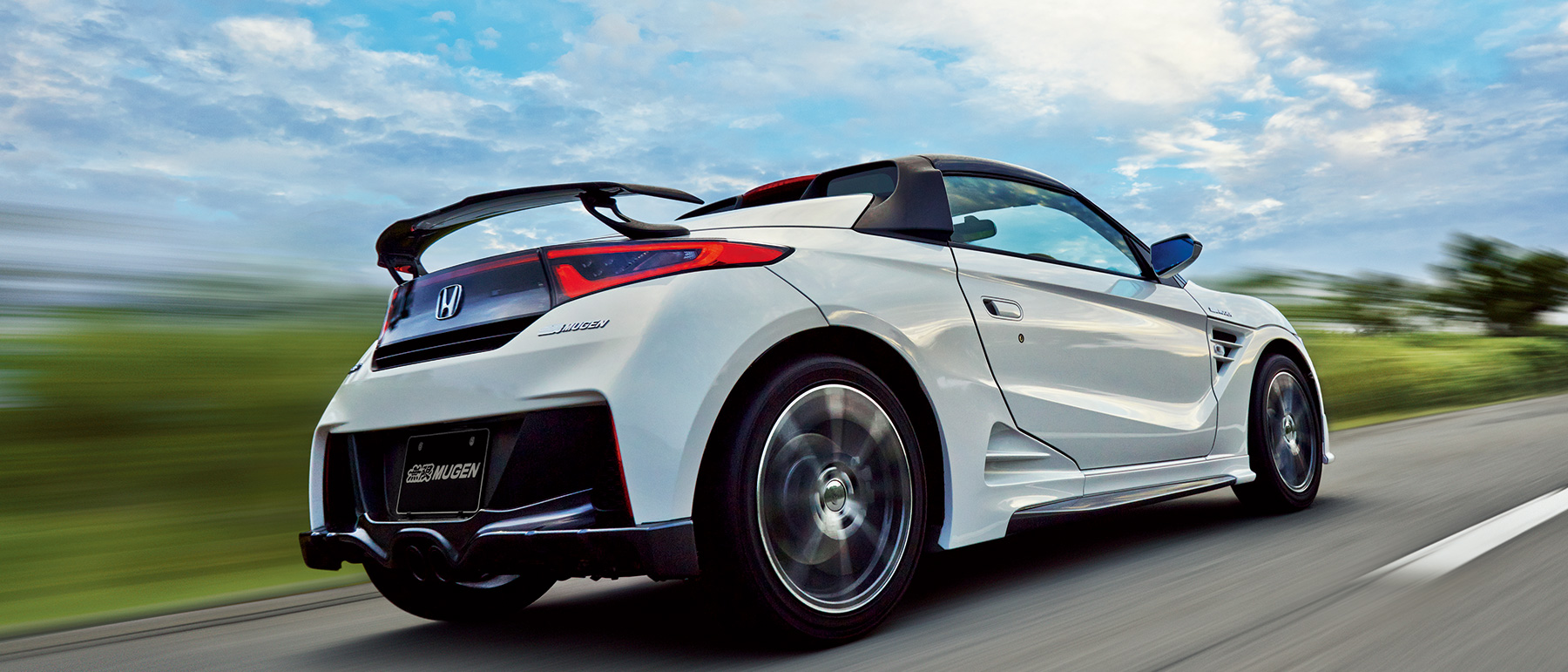
Honda S660 Mugen – 2016 – rear / arrière – on road / sur route
Mugen Motorsports (M-TEC Co., Ltd) (無限)
Mugen Motorsports is a Japanese company formed in 1973 by Hirotoshi Honda, the son of Honda Motor Company founder Soichiro Honda, and Masao Kimura.
Mugen, meaning ‘Without Limit’, or ‘Unlimited’, (hence the commonly placed word ‘Power’ after, denoting ‘Unlimited Power’) is an engine tuner and parts manufacturer closely associated with the Honda Motor Company.
Despite the family connections, however, Mugen is not, and has never been, owned by Honda Motor Company. Things were complicated for some time as Mugen was owned and run by Hirotoshi Honda, who has been the major shareholder in Honda since his father’s death in 1991.
The company tunes and races Honda vehicles in the Super GT championship, and, additionally, sells aftermarket parts to amateur enthusiasts. It was part of partnerships that won the Formula 3000 championship in 1990 and 1991, and that eventually led to Mugen’s involvement in Formula One, from 1992 to 2000, and up to 2005 was the exclusive supplier of Formula Nippon engines.
The company Mugen has a strong racing heritage, as Hirotoshi Honda began building his own racing car in a workshop at his father’s house, shortly before he graduated from Nihon University in 1965. Masao Kimura is a veteran racer with more than 50 victories in Honda sports cars and single-seaters and worked for Honda R&D and then Honda Racing Service before helping Hirotoshi Honda establish Mugen.
The company specializes in tuning Honda engines. Beginning with the 1200 cc Honda Civic engine, it went on to develop, and now designs and builds, both two-stroke and four-stroke engines, manufacturing many of the major components itself.
Mugen ultimately intends to build its own road cars and the first step towards this was the creation of bodykits for the Honda Ballade CR-X in 1984. Since then, the company has produced a number of body kits for Honda machinery, culminating with the Mugen NSX prototype in 1992.
Following Hirotoshi Honda’s tax evasion allegation in late 2003, Mugen was restructured in early 2004 with the establishment of M-TEC. The new company retained the right to use the Mugen trademark and its headquarters in Asaka, Saitama, in the northern suburbs of Tokyo close to the Honda R&D facility at Wako.
Although it is a legally separate entity, M-TEC kept Mugen’s existing staff and is headed by former Mugen board member Shin Nagaosa, who was the engineering division manager at Mugen and been involved with running Mugen’s NSX racing program.
Motorsport story – Mugen Racing
Working with Honda, Mugen has gradually expanded its sporting involvement to all levels of the sport. In 1986, Formula 3000 was introduced into Japan and Mugen joined forces with Honda to build an F3000 engine. It was introduced in the 1987 season and leased to 14 teams. The following year, Mugen won four of the top five places in the Japanese F3000 championship. In 1989, Mugen entered European F3000 with the MF308 engine and won the championship with Jean Alesi, driving an Eddie Jordan Racing Reynard. The same year the company produced its own prototype 3.5L V8 Formula One engine, codenamed MF350.
In 1988, Mugen started tuning Honda engines for use in Formula Three, winning the Japanese series with Akihiko Nakaya, and in 1990 expanded their business to Europe. The same year, Mugen won its first Formula Three championships in Europe, taking the French title with Eric Hélary, and the British crown with Mika Häkkinen at the wheel of a West Surrey Racing Ralt, which repeated the title in 1991 with Rubens Barrichello.
As F3000 became a spec-series in Europe starting in 1996 with the Lola-Judd combo, the Japanese series responded by making Mugen the sole supplier to the Japanese championship, now redubbed Formula Nippon. M-TEC lost the supply contract for the 2006 season, with the rules changing to allow Toyota associate TOM’S to join Mugen as engine supplier. Mugen continues to enjoy success in the Formula Three circuit with its tuned 2.0 L Honda engines, having won 9 titles in Asia (8 of which in Japan) since 1988, as well as 19 titles in Europe (15 of them in Britain), and 13 in Latin America.
In 1991 Mugen prepared Honda V10 engines for Tyrrell but the following year these engines were renamed Mugen MF351H and were transferred to the Footwork team, with drivers Aguri Suzuki and Michele Alboreto. In 1993, Mugen remained affiliated with Footwork and created a B version of the MF351H, used by Aguri Suzuki and Derek Warwick.
At the end of the year, Mugen switched to Team Lotus with plans for a new Lotus 109. The team – with drivers Johnny Herbert and Pedro Lamy (later replaced by Alessandro Zanardi) – was underfunded and the 109 chassis was late arriving. The Mugen engine, codenamed ZA5C, was not able to show its full potential and, after Lotus closed at the end of the year, Mugen switched to the Ligier team, which was then being run for Flavio Briatore by Tom Walkinshaw, with drivers Olivier Panis, Martin Brundle and Aguri Suzuki. The 3.0 L engine, conforming to the new regulations, was codenamed MF301H. The connection with Ligier resulted in Mugen’s first Formula One victory at the 1996 Monaco Grand Prix with Panis at the wheel.
The team was taken over by Alain Prost in 1997, and the newly named Prost Grand Prix ran MF301H-B engines with Jarno Trulli leading the Austrian Grand Prix before suffering engine failure. With Prost establishing a relationship with Peugeot in 1998, Mugen looked for a new partner and reached a two-year agreement with Jordan Grand Prix for which Mugen produced the MF301H-C engine. The 1998 season was not a success until Spa-Francorchamps, when Jordan drivers Damon Hill and Ralf Schumacher scored a 1-2 finish.
In 1998, Mugen built four NSX models, two for the Mugen/Dome partnership, one for Team Kunimitsu and one for Nakajima Racing. The cars were fast but unreliable at first, until the Nakajima NSX scored the car’s first win at the fourth round in Fuji. This was followed by three more wins (one of them by the Mugen/Dome team), which led to a second place championship finish for Tom Coronel and Kouji Yamanishi. In 1999, the Honda took three more wins, one of those with the Mugen/Dome team of Juichi Wakisaka and Katsutomo Kaneishi scoring a victory at the opening round in Suzuka and finishing the third best team in the championship. In 2000, the Mugen/Dome team was champion with Ryo Michigami, but the car’s performance was limited by regulation changes and Michigami reached the title without a single win. Still, Honda won four races, one of them by the second Mugen/Dome car.
The 1999 F1 season resulted in further success with Heinz-Harald Frentzen winning twice, but then the Honda Motor Company announced that it would be returning with its own engines in 2000 with British American Racing. Mugen pulled out of F1 at the end of the 2000 season leaving Honda to supply the engines to Jordan as well.
In 2001, Mugen concentrated once more in the JGTC, the NSX winning two races, and finishing second (Mugen/Dome) and third (ARTA) in the series. More importantly, in June, the company announced development of the a new 4.0 L V8, dubbed MF408S, for the main prototype class in the 24 Hours of Le Mans and American Le Mans Series. At the time, Mugen acknowledged that international sportscar racing was a new category for them. The concept of the MF408S was high power, compact size, durability and reliability. Mugen chose a 4.0 L (N/A) Naturally aspirated engine because they felt through their experience in Formula Three that restrictor size was key to performance. The idea was to save fuel with a smaller displacement engine, since, theoretically, restrictor size will bring power in any engine to a similar level. The main engines in use at the time were producing around 600 hp, including the turbocharged Audi and Cadillac, as well as the larger displacement BMW and the Roush-prepared Ford. Mugen excluded a turbo as this necessitated use of intercoolers to extract maximum performance, which added to the weight and reduced performance.
2002 was a good year for Mugen at the track. The Mugen-prepared NSXs won five rounds, with the Mugen/Dome team winning two races outright, which gave them the Team’s championship title. The debut of the MF408S was in a Panoz chassis in the 2002 Sebring 12 Hours, first round of ALMS.
In 2004, M-TEC decided to drop down to GT300 and help train Japanese drivers for GT500 speeds. By grabbing promising drivers early in their careers, M-TEC would then be able to mold them and have definite access to future champions. M-TEC driver, Hiroyuki Yagi, was sourced from the Integra Series. Giving the drivers experience was more important than developing the car to take the championship. To this end, M-TEC simply detuned the car for the GT300 class without optimizing it for the new power level. Winning the GT300 series by one point over the ARTA Garaiya was simply an unintended bonus for a dedicated, championship-level team.
Breaking into the United States is another goal for the M-TEC team and the Mugen name. Currently, the authorized dealer of Mugen parts in the US is King Motorsports. Team director Junichi Kumakura thought racing the NSX in the United States was a great way to promote the company in a previously unvisited environment. When asked what else M-TEC would like to accomplish in America with the golden NSX, competing at Sebring and Daytona were marked as attractive goals.
source English text via Wikipedia page Mugen Motorsports
Bonus on the Web – Photos via SpeedHunters – Honda S660
Honda Makes Us Dream Again
People, Honda is back! Or at least it’s well on its way to being back. With the new Civic Type R hitting dealerships in Europe and Japan, and the much-awaited new-gen NSX expected to be shown in production-ready form at this year’s Tokyo Motor Show, there’s definitely some excitement being injected back into the brand. But you know what? The NSX and Civic Type R aren’t the first cars that come to mind when I think of the future of Honda. No, it’s actually the tiny S660 that I recently spent a few days driving around Tokyo in…
==> http://www.speedhunters.com/2015/08/honda-makes-us-dream-again/
Sources et images :
Honda, Mugen
via mugen-power.com
Partager la publication "Honda S660 préparé par Mugen Motorsports 無限 Tokyo Auto Salon 2016 : S660 …Without Limit!"

